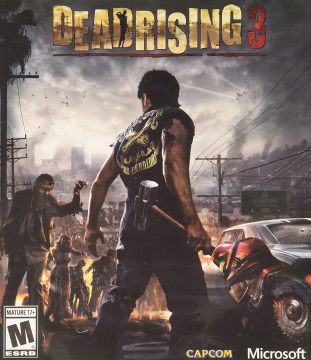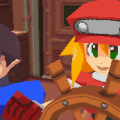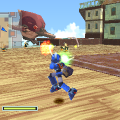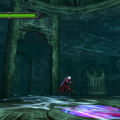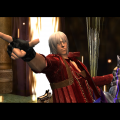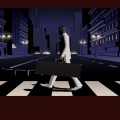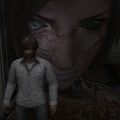- Dead Rising
- Dead Rising 2
- Dead Rising 3
- Dead Rising 4
In November 2013, seven years after the original Dead Rising and three years after Dead Rising 2, Capcom Vancouver would deliver Dead Rising 3; a game in a tug of war with the times and technology, and one ultimately unsure of how much it should embrace, or reinvent, its own roots.
As a launch title, and exclusively for the Xbox One, the sales pitch leaned into what was one of the original’s biggest selling points: what this new and powerful hardware was going to bring to the table. Early release material boasted three times the zombies on screen as Dead Rising 2, and also aimed for no load screens, short load times, and a large, open-world that could fit both maps from the previous games inside. The developers, in many ways, were pushing the series’ sandbox formula to meet the limits and standards of the time. However, while previous Dead Rising games were their own early and focused novelty within an emerging sandbox genre, AAA conventions of the time had changed what a sandbox game had to be. 2013 saw the likes of Grand Theft Auto 5, Saints Row 4, Assassins’ Creed IV: Black Flag, and Batman: Arkham Origins, and the ways Dead Rising 3 would try to be those games was, for some, what upended the experience as whole.
Despite promising to be the biggest and, in a lot of ways, most accessible Dead Rising game yet, one harsh detail announced early on was that, while Dead Rising 2 had been been on both Xbox and PlayStation consoles (a first for the series), Dead Rising 3 would stay on Xbox One, and would only, eventually, get a release on Windows. Developers would later explain that the early builds were plagued by technical issues on the Xbox 360 and PS3, and so, out of necessity, the partnership and exclusivity with Microsoft was made to give developers a more powerful console to make their open-world vision possible, buy the team more funding, another year of development, and a larger marketing budget. However, while the developers desire to push the technology of the time can be appreciated and understood even now, how they filled their open world (and their stated desire to see the franchise “mature”) would bring more changes made to the Dead Rising formula and aesthetic than any previous installment.
When the game was shown off at E3 2013, many fans were taken aback by the darker lighting, the lack of bright colors, and what looked to be a bleaker, less glitzy and silly world. Past Dead Rising games visited more fun, “stuff filled” places that had been sharpened to a satirical point to comment on and indulge in the lights, activity, and excess. But the larger world of Dead Rising 3 was being shaped by the developers desires to re-inject feelings of fear, survival, and reality into the series (it might also be worth noting that the popular TV show The Walking Dead had begun airing in 2010). According to the devs, after two games, Capcom Vancouver wanted its world and its zombies to feel scary again, and so, thought the visuals, environment, and overall tone should follow suit.
So, taking place 10 years after Dead Rising 2 (and 15 years after the first game), Dead Rising 3 sets its zombie outbreak in the sprawling, fictional, California city of Los Perdidos. Written to be “one of the largest cities in Southern California”, and feeling like a general riff on Los Angeles, the map itself is made up of four districts, each comprised of different neighborhoods, buildings, and layouts meant to capture a different kind of cultural and socioeconomic environment (mansions and rich people are in the hills, for example) with an interconnecting highway system in between.
The protagonist this time around is the brand new, Nick Ramos (a mechanic with a mysterious past), and feels like a different kind of hero than in previous games. If Frank West from Dead Rising was self centered and jokey, and Chuck Greene from Dead Rising 2 was distracted and disinterested (albeit because his daughter mattered more), Nick was made out to be more sensitive, self reflective, and caring, and even goes on his own journey of self discovery within the happenings of the main plot, too. There’s more shoe-horned-in relationships between Nick and his fellow survivors, but also more direct connection and conversation, and moments where Nick is allowed to be affected and overwhelmed by the situation as opposed to just quippy (which was refreshing in parts).
This time around, the government is planning to bomb the city into the ground to stop another zombie outbreak (again), and it’s up to Nick to find a way out for his small group of friends and fellow survivors. There’s a generic resistance group, Nick’s mysterious past, betrayals, and a big-brother angle of government surveillance and overreach. Those who are infected, but do not register and agree to be micro-chipped with an auto-dosing device delivering Zombrex (the medicine that keeps people from turning into zombies), are branded as “illegals”, and are blamed by the government and its ordinary citizens for the outbreak. The plot is definitely trying to deliver depth and intrigue, but feels more heavy-handed, inconsistent, and overreaching than anything, and doesn’t stop Nick from feeling like a pawn caught up in a whirlwind of over the top antagonists, predictable outcomes, and silly and ungrounded twists. It also doesn’t help that the game has its cringy characterizations, weak jokes, and an over-serious tone either. The developers openly stated their goal was to see the series to mature and grow, with the hopes that what comedy remained would stand out in stronger contrast to Dead Rising 3’s grim, and slightly more “down to earth” tone and environment.
Regrettably however, this might be the worst, or just most frustratingly written Dead Rising game yet. While some of the larger moments and past-game character callbacks effectively paint a bigger and more connected picture for the series, parts of the world building and side writing come up short. Nick is constantly doing tasks from a faceless voice on the radio (who we never see), and some of the survivors are meant to to be, circumstantially, “very LA”, but just feel unsympathetic, shallow, or weird (like a RV owner with engine trouble and needs help, but also says he has more experience than Nick’s had government handouts, a fashion model wearing a meat dress who wants you to take her shopping, or a gardener who is so mad at his rich employers that he wants you to bring him chunks of meat to eat…for revenge).
Even the psychopaths (mini-bosses with their own unique patterns and animations) which had been a staple for the series and typically offer some bit of levity, commentary, and danger, felt under baked. Each is meant to be modeled after one of the seven deadly sins, but the reference doesn’t make many of them feel any more well realized, or justified for being where they are and doing what they’re doing (“wrath” is represented by a blood stained monk in a zen garden, upset over life and belittlement from his family; “gluttony” is an overweight woman on a mobility scooter; “greed” is an organ harvesting surgeon; “lust” is a psycho-sexual BDSM performer; “sloth” is a lazy mayor who sends RC helicopters to attack you in his mansion). What makes them functionally less intimidating, however, has a lot to do with how the rest of the series’ core mechanics have been tweaked.
While there’s been plenty of changes that sound interesting on paper, most of them make the overall play less interesting than before. While a light and heavy attack button sounds nice, some of the heavier, and slower swinging, but more powerful sweeping attacks from various weapons feel neutered, and this makes a lot of weapons feel functionally similar, if not identical down to the animation used. You can now craft combo weapons and combo vehicles from anywhere (past games required a dedicated workbench, found in maintenance rooms littered throughout the map), which can feel liberating initially, but crafting now requires finding the recipes for those combinations first. This gives players more things to “find” throughout the map, but also eliminates some of the fun and surprise in discovering wacky weapons through trial, error, and intuition.
The game also adds “Weapons Lockers” in safe-houses (where you can grab any weapon you’ve found or made before, albeit only so many at a time), which make having to use what you find on the fly feel less typical than just carrying around a few copies of your overpowered favorites at all times. There are over 100 combo weapons, and 37 super-combo weapons (which are combo weapons with more objects added on) but there’s a lot of similar versions of the same thing, and plenty of useless combos, so, while it might feel exciting early on to have so much to find, you’ll more than likely begin ignoring what’s around and sticking to a few functional standards that you pull from weapon lockers as needed.
In the same mechanically uneven vein, you can now rescue some survivors without having to take them back to a safe zone (like in previous games), and others will actually follow Nick to form a “posse” of support. These followers have their own stats, and can be summoned or de-summoned from a safe-house, and this sounds great, and can make psychopath fights a little less intimidating by having some company. However, when the AI can also slow you down just as easily, and combo weapons make the horde of zombies easy enough to kill already, the changes feel like as much of a step forward as a step back when it comes to making the game scarier, but safer, and easier, but differently frustrating.
The tragedy being that, while a lot has been smoothed out in regards to quality of life improvements and eliminating pain points, all these changes do as much to water down the core experience, making Dead Rising 3 feel, in a lot of ways, like the least Dead Rising game yet. One of the best examples of this awkward evolution of the original formula is, surprisingly, the developers push for a large, open world map and the ripple effects it had on so many other aspects of the game.
There’s more verticality to the level design, which makes climbing and exploring more fun, but the massive space feels hampered by doors that are locked for seemingly no reason, and others that are completely nonfunctional. The city’s sections have a clear world building intent to them (the rich live in Sunset Hills with mansions, winding roads, and elevated landscaping; luxurious shopping and most of the businesses build the “downtown” vibe of Central City; South Almuda has the train yards, docks, liquor stores; and the congested and aging Ingleton is where most of the working class people live), but the sprawl makes a lot of neighborhoods feel copy pasted or just plain unmemorable. Even the moment to moment pacing of the gameplay feels hampered by the design and execution of the large, open world itself.
Streets are congested and choked with road blocks, destruction, and visual “drama” (which feels “realistic”), but this makes back tracking, and overly spread out fetch quests feel monotonous and repetitive; not mention near impossible in some parts of town with an obnoxiously wide combo-vehicle. While driving had existed in Dead Rising games before, traversing a map this large in Dead Rising 3 makes it an outright necessity and a constant requirement, not so much a temporary and potentially dangerous choice you made because you were short on time (breaking down in a car in Dead Rising meant being surrounded by zombies in a tunnel, with nothing but your feet to get you out).
Similarly, easier access to weapon combos, checkpoint saves, and map icons sound alright by themselves (and pretty standard for the time), but, taken together, it means this isn’t really a thrilling and difficult survival horror game as much as it is a mindless, padded, open world action-game with repetitive encounters and a mini map overstuffed with “go here to grab this”. Very small changes like having icons alert you to where things are on the map means you’re not searching in vein for stuff to find, but it also means you’ll most likely be floating mindlessly from objective to objective instead of soaking in and truly exploring your environment, and you’ll never be surprised by a psychopath fight you weren’t expecting like in the previous two.
The original Dead Rising could feel dangerous and frustratingly unknowable in parts. Walk into the wrong area at the wrong time, and a mini boss would force a restart of the whole game. New players would simply run around and explore haphazardly, but, over time, knowledge turned the game into a straight line of learned efficiency – like a game who’s walls built you into a speedrunner automatically. Getting to know the layout of the mall, its secrets and shortcuts, felt like their own reward. Over time, the danger and fear melted away despite the character never being made particularly powerful with, say, a battery charged sledgehammer, or needing the zombies to become super zombies or bullet sponges for the sake of difficulty balance.
There’s still improvements to love, some exciting boss fights, and Dead Rising 3, technologically speaking, is the most powerful and impressively zombie-filled Dead Rising game to date. Zombies pour over walls, come out of holes, grab you from the ground, and there’s more variety in enemy types, with a few using their visual styling to broadcast their means of attack (football players from the high school will charge and tackle you, for example). But so much feels so different, and so similar to other games you’ve already played.
In the end, Dead Rising 3 impresses, but also underwhelms, undercuts its past ideas, and feels like a mixed bag of grand ideas and stagnating scope, of familiar kinds of fun saddled with aging conventions, of welcome change and a myriad of quality of life improvements offset by bloat, blandness, groans, and missed opportunities. What’s fun about these games, at their core, is still present in some form (even if the desire to make killing zombies easier than ever, ultimately, makes the experience a bit less of a “Dead Rising” game), but the attempts to evolve, solve every problem, and be different, in some ways, only serve to highlight the unevenness and a lack of a clear and cohesive future direction beginning to plague the franchise.
Making the game so much like every other open world game, without truly recognizing or appreciating what made the earlier sandbox experiences so different and enjoyable, was truly a letdown as a fan of the series. With all that being said, Dead Rising 3 is still a decently fun game that’s enjoyable in parts. There’s also four DLC mini episodes from the perspective of other characters during the outbreak, and an arcadey and zany, costume filled 5th expansion that lets four players compete for a high score. But for every gold star I could give one aspect of it, I feel as inclined to mention the parts that grated, and left me feeling a bit worn out by the end.
